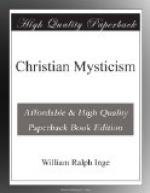[Footnote 331: The most recent developments of German idealistic philosophy, as set forth in the cosmology of Lotze, and still more of Fechner, may perhaps be described as an attempt to preserve the truth of Animism on a much higher plane, without repudiating the universality of law.]
[Footnote 332: I refer especially to Huysmans’ two “mystical” novels, En Route and La Cathedrale. The naked Fetishism of the latter book almost passes belief. We have a Madonna who is good-natured at Lourdes and cross-grained at La Salette; who likes “pretty speeches and little coaxing ways” in “paying court” to her, and who at the end is apostrophised as “our Lady of the Pillar,” “our Lady of the Crypt.” It may perhaps be excusable to resort to such expedients as these in the conversion of savages; but there is something singularly repulsive in the picture (drawn apparently from life) of a profligate man of letters seeking salvation in a Christianity which has lowered itself far beneath educated paganism. At any rate, let not the name of Mysticism be given to such methods.]
[Footnote 333: I refer especially to the horrors connected with the belief in witchcraft, on which see Lecky, Rationalism in Europe, vol. i. “Remy, a judge of Nancy, boasted that he had put to death eight hundred witches in sixteen years.” “In the bishopric of Wartzburg, nine hundred were burnt in one year.” As late as 1850, some French peasants burnt alive a woman named Bedouret, whom they supposed to be a witch.]
[Footnote 334: The degradation of Mysticism in the Roman Church since the Reformation may be estimated by comparing the definitions of Mysticism and Mystical Theology current in the Middle Ages with the following from Ribet, who is recognised as a standard authority on the subject: “La Theologie mystique, au point de vue subjectif et experimental, nous semble pouvoir etre definie; une attraction surnaturelle et passive de l’ame vers Dieu, provenant d’une illumination et d’un embrasement interieurs, qui previennent la reflexion, surpassent l’effort humain, et peuvent avoir sur le corps un retentissement merveilleux et irresistible.” “Au point de vue doctrinal et objectif, la mystique peut se definir: la science qui traite des phenomenes surnaturels, soit intimes, soit exterieurs, qui preparent, accompagnent, et suivent la contemplation divine.” The time is past, if it ever existed, when such superstitions could be believed without grave injury to mental and moral health.]




